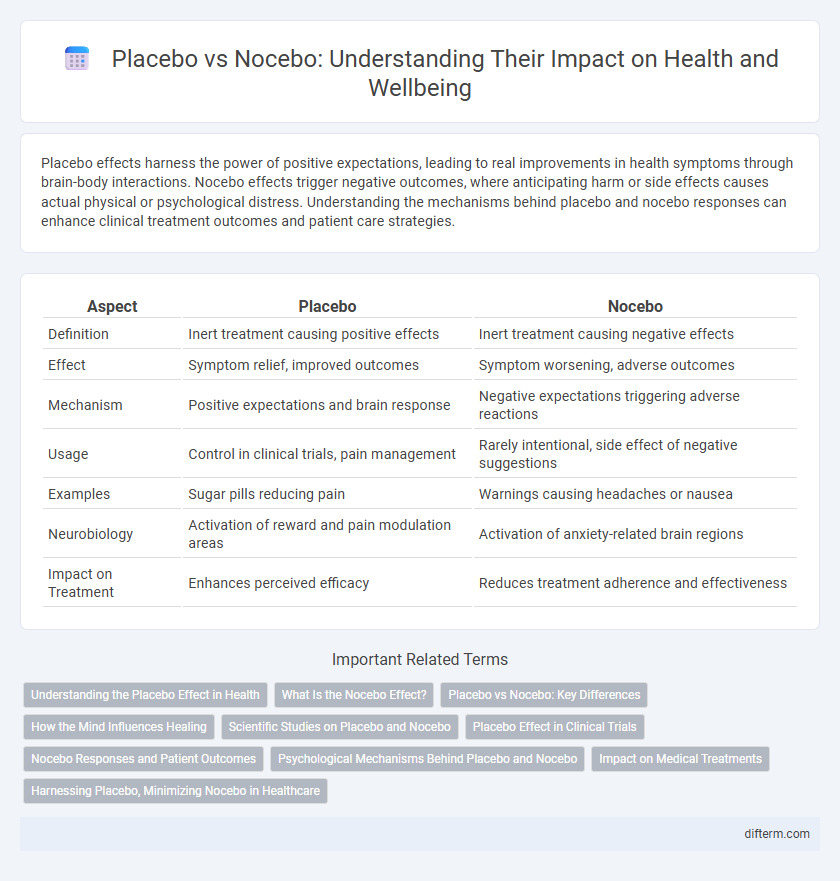Placebo effects harness the power of positive expectations, leading to real improvements in health symptoms through brain-body interactions. Nocebo effects trigger negative outcomes, where anticipating harm or side effects causes actual physical or psychological distress. Understanding the mechanisms behind placebo and nocebo responses can enhance clinical treatment outcomes and patient care strategies.
Table of Comparison
| Aspect | Placebo | Nocebo |
|---|---|---|
| Definition | Inert treatment causing positive effects | Inert treatment causing negative effects |
| Effect | Symptom relief, improved outcomes | Symptom worsening, adverse outcomes |
| Mechanism | Positive expectations and brain response | Negative expectations triggering adverse reactions |
| Usage | Control in clinical trials, pain management | Rarely intentional, side effect of negative suggestions |
| Examples | Sugar pills reducing pain | Warnings causing headaches or nausea |
| Neurobiology | Activation of reward and pain modulation areas | Activation of anxiety-related brain regions |
| Impact on Treatment | Enhances perceived efficacy | Reduces treatment adherence and effectiveness |
Understanding the Placebo Effect in Health
The placebo effect in health demonstrates how patients experience real physiological improvements after receiving inactive treatments, driven by their expectations and beliefs. This phenomenon highlights the brain's powerful role in modulating pain, immune response, and symptom perception through neurochemical pathways such as endorphin release. Understanding placebo mechanisms can enhance clinical outcomes by optimizing patient-practitioner interactions and leveraging positive treatment expectations.
What Is the Nocebo Effect?
The nocebo effect occurs when negative expectations or beliefs about a treatment lead to adverse health outcomes, despite the treatment having no harmful ingredients. It manifests through psychosomatic symptoms such as headaches, nausea, or increased pain, triggered purely by the patient's mindset. Understanding the nocebo effect is crucial for healthcare providers to improve patient communication and minimize unintended negative side effects during medical interventions.
Placebo vs Nocebo: Key Differences
Placebo effects generate positive health outcomes through patients' beliefs in treatment efficacy, while nocebo effects cause negative symptoms due to expectations of harm. The placebo activates brain pathways associated with pain relief and well-being, whereas the nocebo triggers anxiety and stress-related physiological responses. Understanding these mechanisms is crucial for optimizing clinical interventions and improving patient care outcomes.
How the Mind Influences Healing
The mind's power significantly impacts healing through placebo and nocebo effects, where positive expectations trigger beneficial physiological responses, and negative beliefs provoke harmful symptoms. Neurobiological mechanisms involving endorphin release, immune modulation, and brain activity changes underpin these phenomena. Understanding the placebo-nocebo dynamic enhances treatment efficacy by harnessing psychological factors to optimize patient outcomes.
Scientific Studies on Placebo and Nocebo
Scientific studies on placebo and nocebo effects reveal significant implications for patient outcomes and treatment efficacy. Placebo responses activate brain regions involved in pain relief and emotional regulation, while nocebo effects often trigger anxiety and symptom worsening through negative expectations. Research emphasizes the importance of patient-clinician communication and the psychological context in modulating these phenomena to optimize therapeutic interventions.
Placebo Effect in Clinical Trials
The placebo effect in clinical trials significantly influences patient outcomes by triggering physiological and psychological responses despite the absence of active treatment. This phenomenon enhances the reliability of drug efficacy assessments by serving as a control, allowing researchers to distinguish between a drug's true therapeutic effects and patients' expectations. Understanding placebo-induced neurobiological mechanisms is crucial for optimizing trial design and interpreting clinical results.
Nocebo Responses and Patient Outcomes
Nocebo responses can significantly affect patient outcomes by triggering adverse symptoms due to negative expectations or beliefs about treatment. These physiological changes often exacerbate perceived side effects, complicating clinical assessments and reducing treatment efficacy. Understanding nocebo mechanisms is critical for healthcare providers to minimize negative impacts and improve patient adherence and recovery rates.
Psychological Mechanisms Behind Placebo and Nocebo
Placebo and nocebo effects are driven by brain mechanisms involving expectations and conditioning, where positive expectations trigger the release of endorphins and dopamine, enhancing pain relief and healing. Negative expectations activate areas such as the hypothalamus and amygdala, inducing stress responses and worsening symptoms through increased cortisol and anxiety levels. Neuroimaging studies reveal overlapping yet distinct neural circuits that mediate these opposite psychological influences on health outcomes.
Impact on Medical Treatments
Placebo effects can significantly enhance medical treatment outcomes by triggering positive physiological responses through patient expectations and belief in the therapy. In contrast, nocebo effects may hinder recovery and exacerbate symptoms due to negative expectations and anxiety, often leading to increased side effects and reduced efficacy of medications. Understanding and managing placebo and nocebo responses are crucial for optimizing clinical practices, improving patient adherence, and tailoring personalized healthcare interventions.
Harnessing Placebo, Minimizing Nocebo in Healthcare
Harnessing placebo effects in healthcare enhances patient outcomes by leveraging positive expectations and the brain's natural healing mechanisms. Minimizing nocebo responses requires careful communication strategies that avoid negative suggestions and emphasize reassurance. Integrating these approaches optimizes treatment efficacy and patient satisfaction while reducing adverse psychological impacts.
Placebo vs Nocebo Infographic

 difterm.com
difterm.com